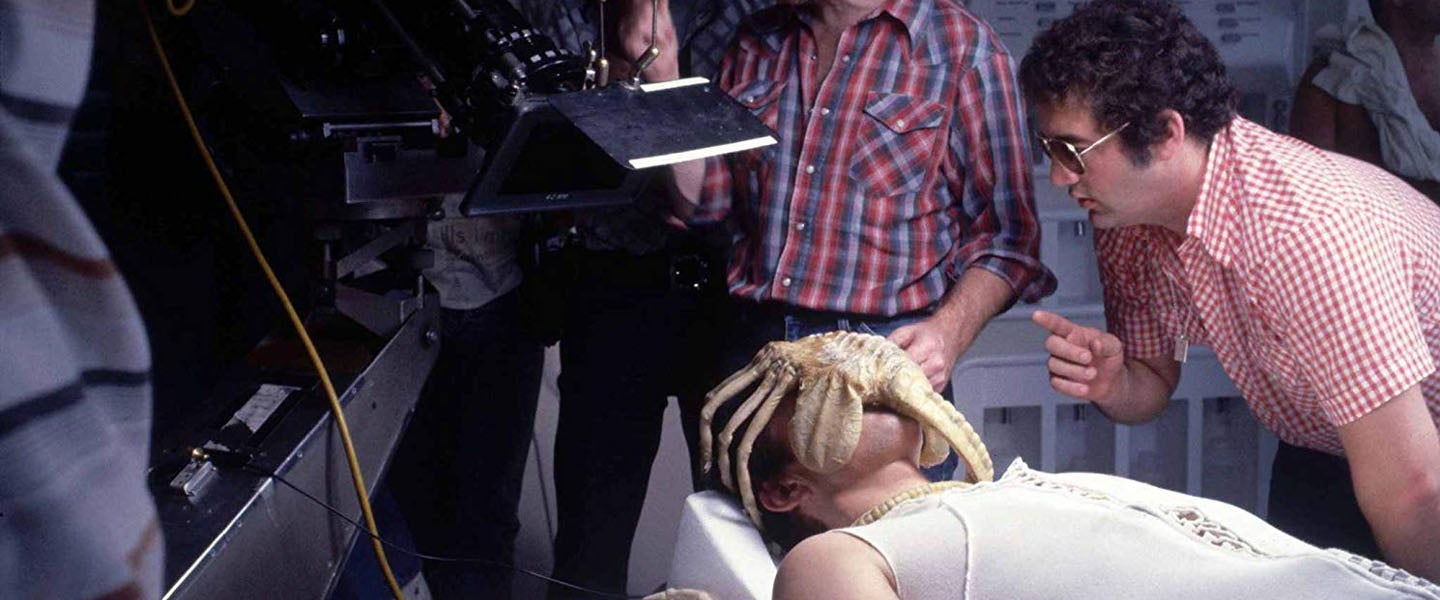I know exactly the moment when the alien bursts from John Hurt’s chest.
It still shocks me every time: It starts shortly after his character, Kane, prepares to take a bite after engaging in some banter with his crewmate, and for a few seconds, it looks like he’s just swallowed wrong. Then it escalates into a seizure and convulsions, then… well, if you’ve seen the movie, you know what happens next. It’s nightmarish, no matter how many times you’ve seen it.
Ridley Scott’s 1979 film Alien ranks among the films I’ve seen the most over the years, and I know a lot about its history, too, thanks to Ridley Scott’s audio commentary, books like David Thomson’s The Alien Quartet and Jason Zinoman’s Shock Value and documentaries like Alexandre O. Philippe’s new film Memory: The Origins of Alien (which opens in a few theaters this weekend before rolling out more largely over the next few weeks). Alien should have no secrets for me. So why does it still work?
That’s a question that could apply to just about any film that’s inspired moviegoers to peek behind the curtain. And all evidence suggests we want to know what’s back there: Movie magazines have existed since the days of the nickelodeon (in fact, one early magazine for exhibitors was called simply: The Nickelodeon). Studios understood the value of letting moviegoers in on behind-the-scenes details, too — for instance, IMP, a company later part of the merger that formed Universal, published issues of The Implet throughout 1912, cluing fans into hot new releases like The Greatest Dam in the World and O’Brien’s Busy Day.
The desire to understand the tricks of the trade reached a fever pitch in the 1950s and 1960s, with the introduction of magazines dedicated to the stories behind famous genre films, a trend continued in later decades by titles like the recently revived Fangoria, which mixes interviews, horror movie news and critical reflections with detailed descriptions of how special effects teams pulled off their tricks.
Add to this book-length Hollywood histories, making-of documentaries and the DVD boom, which in its heyday seemed to treat virtually every film as the subject of scholarly inquiry (want to hear John Madden gab about making Captain Corelli’s Mandolin for two straight hours? You’re in luck!) And though that tradition has been imperiled by the decline of physical media, the internet has helped pick up some of the slack, subjecting seemingly every big film to intense scrutiny as part of a never-ending cycle of rumor and hype. Even if you haven’t seen Joker, for instance, you probably still know a lot about it.
Which raises another question: Why do we want to look behind the curtain in the first place? Why is just experiencing the movies not enough? Getting to look behind the curtain ought to spoil the illusion, but if anything, it has the opposite effect. When the movie’s good, it doesn’t matter — it even enhances the experience. Yet, logically, it shouldn’t. Knowing, for instance, that Jaws had trouble keeping its mechanical shark operational, forcing Steven Spielberg to get creative and rely on suggestion rather than images, ought to be a distraction. So should the knowledge that Quint’s U.S.S. Indianapolis monologue is the result of a collaboration between many uncredited writers, including John Milius and actor Robert Shaw. But the moviegoing mind is a funny thing. It’s possible to know these facts but hold them on a separate track from the part that’s experiencing the film — you can fear the unseen threat the hapless swimmer doesn’t know awaits her, or get swept up in the drama of Quint’s tale, while still knowing how each moment came to be.
The same goes for special effects. Having seen Robert Downey Jr. and others playing superheroes against a green screen ought to make it hard to take the same images seriously once computer effects have filled in the blanks. But who thinks about that when the threat of Thanos — a character created by putting Josh Brolin in a skin-tight suit topped by an elaborate headset — looms on the horizon? It’s possible to appreciate the craftsmanship while simultaneously forgetting it. The making-of specials that aired on TV when I was a kid clued me in to the tricks behind Ray Harryhausen’s stop-motion creations and Star Wars’ miniatures, but took nothing away from the former’s fighting skeletons or the latter’s Death Star finale.
Why is this? Science might provide some answers. In a 2009 Psychology Today piece, literary critic Norman Holland summed up some experiments conducted by a pair of Israeli neuroscientists who monitored subjects watching The Good, the Bad and the Ugly. What they found: the parts of the brain devoted to sensory perception and following the plot functioned more or less the same in every viewer, but the parts devoted to advanced interpretation varied wildly from subject to subject. In other words, everyone saw the same movie, but how they processed it and what they brought to the experience changed by how they felt about what they saw. And, for a certain strand of filmgoer — the type to dig into Blu-ray supplements or watch a feature-length documentary about the making of Alien — knowing how a movie is made leads to a richer interpretation.
Yet the mystery of why we continue to let ourselves be fooled remains harder to explain. Maybe David Lynch has the answer: In the most stunning sequence in Mulholland Drive, central characters Betty (Naomi Watts) and Rita (Laura Elena Harring) visit the mysterious Club Silencio, where the emcee warns them in advance that everything they’re about to see is an illusion. Then they watch as singer Rebekah Del Rio takes the stage to deliver a stunning Spanish-language rendition of Roy Orbison’s “Crying.” Lynch holds on Betty and Rita’s faces as they become swept up in the emotion of the song, and for those watching the movie, it’s hard not to join them. Then the singer collapses but the song continues. It was all, as they’d been told, an illusion, but that didn’t stop them for falling for it, and it didn’t make the emotions any less real. Trite or not, maybe the only real explanation is movie magic.
Which brings us all the way back to Alien and Philippe’s film. Phillippe takes the subtitle of Memory: The Origins of Alien seriously, especially the plural form of “origin.” Alien is a film with many sources of inspiration, many of them traceable to Dan O’Bannon, its original screenwriter (he wrote the story in collaboration with Ronald Shusett, then the script passed through many hands) and a key shaper of its visuals. A science fiction-obsessed kid from St. Louis, for Alien, he drew on everything from old EC Comics stories to his own struggle with Crohn’s disease, which helped inspire him to dream up a monster emerging from within the human body. To give form to his nightmares, he recruited Swiss artist H.R. Giger, a choice that met with resistance until Ridley Scott signed on to direct. Other sources of inspiration for the Alien team included wasps, artist Francis Bacon, It Came from Outer Space and H.P. Lovecraft.
Memory: The Origins of Alien lays it all out for viewers to see, from O’Bannon’s notebooks to behind-the-scenes footage of the shoot. This includes a long sequence dedicated to the chest-burster scene, which starts with dispelling the myth that the rest of the cast didn’t know what they’d be seeing. The scene involved too much prep, and besides, the set stank of offal used to create the gore, which had started to bake under the hot lights. The doc includes photos of Hurt’s half-submerged body, reveals the pipes that shot the gushers of blood that prompted Veronica Cartwright deliver one of the most chilling exclamations of “Oh God!” ever heard, and footage of failed takes in which the creature couldn’t quite puncture the fabric of Kane’s shirt (it was just a baby xenomorph, after all). It tells you everything you could want to know about that disturbing, thrilling moment: You leave it knowing not just how the magician performed the trick, but the many sources that went into inspiring the trick in the first place.
Yet the magic remains. Why can’t be explained, but it also can’t be explained away — watch Alien again and it will remain just as disturbing as the first time, maybe even more. It’s the sort of rich film that rewards close study. Look in the background of the chestburster scene just before all hell breaks loose, as one of Phillippe’s interview subjects notes, and you’ll see Jones the cat chowing down in the background while his human shipmates eat in the foreground. Watch Ian Holm’s performance as Ash and the way his eyes lock onto Kane just before the coughs begin, as if he knows what’s coming. And though we definitely know what’s coming, knowing doesn’t make the moment any less magnetic, nor does knowing how it’s done, or what inspired it. It just draws us in deeper by making us consider not just what we’re seeing, but why we’re seeing it, and why, of all the possible worlds the filmmakers could have created, this is the one they chose.

